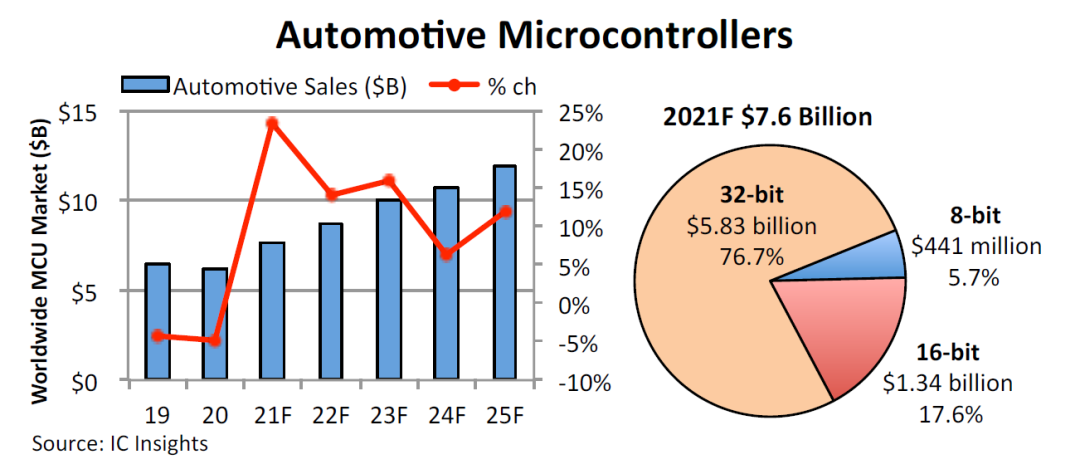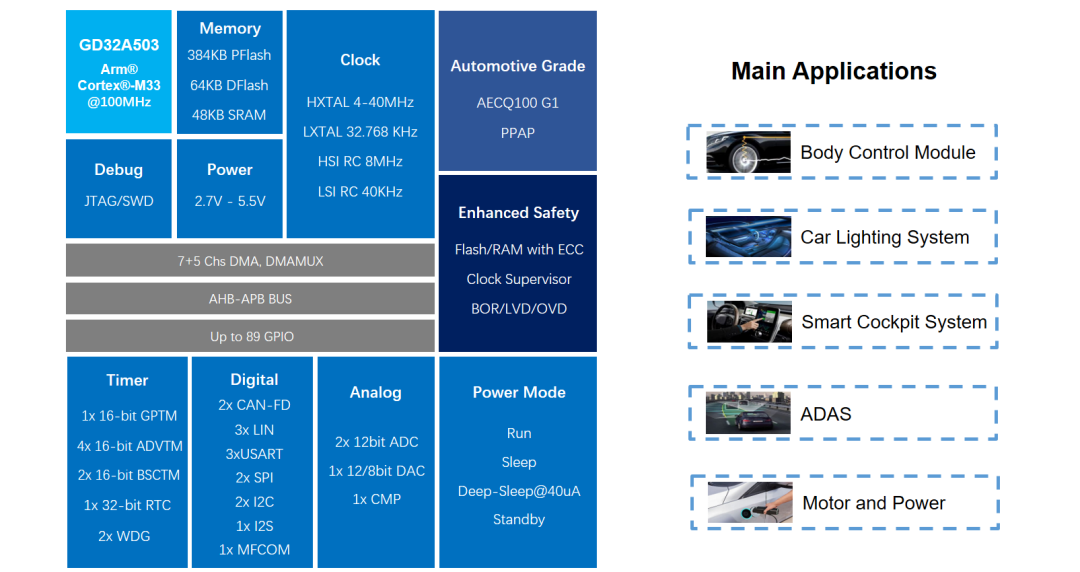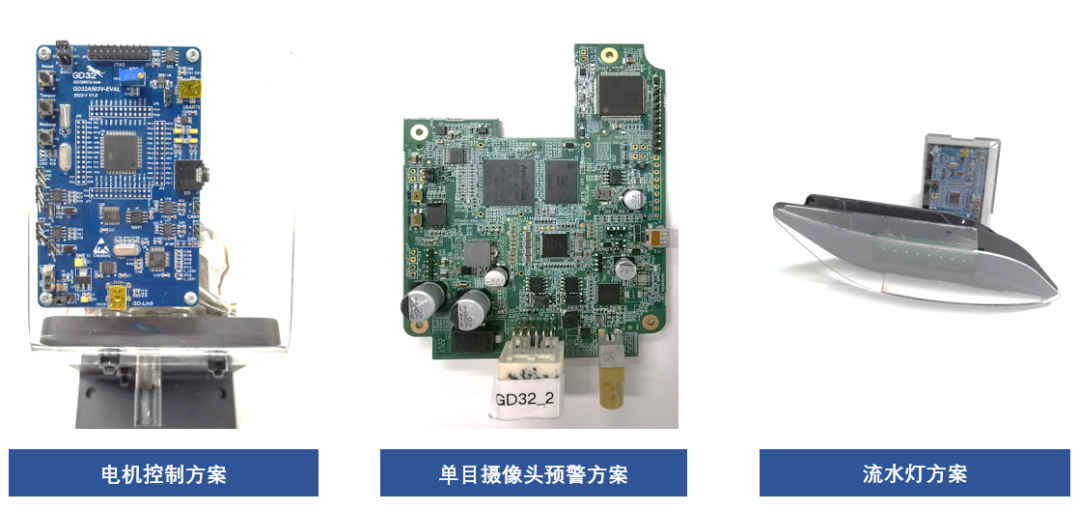With the increasing trend of electrification, intelligence, and connectivity in the automotive industry, the demand for chips and electronic components is growing exponentially. Traditional automotive electronic component companies are unable to fully meet the innovative functional demands of automotive applications, and they are struggling to respond to the design and procurement needs of numerous new automotive manufacturers. The industry requires more excellent chip companies to engage in the automotive component supply chain. In particular, many MCU manufacturers have also recognized the upgrade opportunities in automotive components and have entered the automotive industry.
According to IC Insights statistics, the automotive MCU market experienced a slight growth and even negative growth from 2018 to 2020, but in 2021, it saw an explosive increase of 23%, with sales reaching $7.6 billion. The agency predicts that the market will maintain a compound annual growth rate of 16% in 2022 and 2023. Of the $7.6 billion in global market sales, more than three-quarters are contributed by 32-bit MCUs, amounting to $5.8 billion, while 16-bit MCUs generated $1.3 billion, and 8-bit MCUs generated $441 million. It is expected that 32-bit MCUs will continue to encroach on the market share of 16-bit and 8-bit MCUs in the future.

▲ Global Automotive MCU Market Size Statistics and Forecast
(Image source: IC Insights)
Industry Structure Reshaping
GD32A503 Series Automotive-grade MCU Emerges
Recognizing the significant changes in the automotive supply chain, many semiconductor manufacturers have begun to enter the automotive market, and GigaDevice is one of them. “Entering the automotive market is an inevitable path for the continuous iteration and evolution of the GD32 MCU product family, and the current period is a historical opportunity that cannot be missed. In addition to valuing the long-term blue ocean attributes of this field, the company’s existing product planning and technological accumulation have also prepared it for entering the automotive-grade MCU market,” said Mr. Jin Guangyi, Product Marketing Director of GigaDevice.
It is well known that automotive-grade MCUs have different requirements and standards compared to general-purpose MCUs, needing to cross three thresholds: quality management system certification IATF16949, reliability standard AEC-Q100, and functional safety standard ISO26262. To plan and design MCU products that meet automotive application requirements, GigaDevice began its layout for automotive-grade MCUs in 2020. After more than two years of development and validation, the 40nm automotive-grade MCU product GD32A503 series was officially launched in September 2022.
The GD32A503 new product adopts a 40nm automotive-grade process and high-speed embedded flash memory eFlash technology, introducing DFM manufacturability design and high test vector coverage. It features excellent electrostatic protection and anti-interference (ESD/EFT) capabilities, meeting the stringent low failure rate and high reliability requirements of automotive electronics.
The development of GD32A503 is based on the automotive electronics general testing specification AEC-Q100 Grade 1 standard, and the wafer testing and production supply chain management have also been certified by the automotive industry quality management system IATF 16949:2016. The zero-defect quality control concept runs through all stages of research and development and production processes, emphasizing preventive system control and process control, ensuring high quality and high reliability of the products.
The GD32A503 series MCUs are based on a 100MHz Cortex®-M33 core, equipped with 384KB Flash and 48KB SRAM, with additional dedicated code space configurable as 64KB DFlash/4KB EEPROM. The memory supports ECC verification, data communication supports CRC verification, and it is equipped with functional safety mechanisms such as high and low voltage monitoring (BOR/PDR) and clock monitoring to support the safe and stable operation of the system. The chip operates on a wide voltage supply of 2.7-5.5V and has an operating temperature range of -40 to +125°C, with a lifespan of over 15 years.
To achieve diversified body control and interconnected applications, the GD32A503 integrates various communication interfaces to enhance connectivity, supporting up to 3 USARTs, 2 I2Cs, 2 SPIs, 1 I2S, and is also equipped with 2 CAN FDs and 3 LINs. Depending on development application needs, the newly added MFCOM component can be flexibly configured as USART/SPI/I2C/LIN interfaces, further enhancing the flexibility of solution design. The chip is equipped with 1 general-purpose 16-bit timer, 2 basic timers, and 4 PWM advanced timers. The internal 12-bit ADC sampling rate can reach 1M SPS, and it also integrates high-precision analog peripherals such as fast comparators and DACs to support automotive motor control.

▲ GD32A503 Series Automotive-grade MCU System Block Diagram
Unlike manufacturers that directly integrate purchased IP libraries to launch products, GigaDevice has chosen a steady and solid path to demonstrate its strength in automotive-grade development. According to Mr. Jin, the company has established a dedicated R&D team for automotive-grade MCUs, conducting independent research and development from digital interfaces to analog peripherals, from functional safety to quality management, and owning independent intellectual property. This not only enhances the stability and consistency of automotive-grade products but also maintains continuity and compatibility with other GD32 product lines. The GD32A503 series automotive-grade MCUs are entirely designed using GigaDevice’s self-developed IP library, which includes various high-quality and high-reliability digital and analog IPs that have been tested through hundreds of millions of mature mass production. This approach avoids the constraints and limitations of purchased resources, allowing for continuous accumulation of mature experience, accelerating product layout and iteration, and assisting customers in enhancing their industry competitiveness.
With numerous excellent features, the GD32A503 series MCUs can be widely used in various automotive scenarios, such as windows, wipers, air conditioning, smart locks, electric seats, electric trunks, and body control systems, lighting systems such as ambient lights and dynamic taillights, as well as smart cockpit systems including dashboards, in-car audio, entertainment systems, central navigation, and in-car wireless charging. Thanks to its excellent safety monitoring mechanisms, the GD32A503 is also suitable for some ADAS (Advanced Driver Assistance Systems), such as surround view cameras and AVAS acoustic warning systems.
Ecological Resource Sharing
GD32A503 Lowers the Innovation Threshold for Automotive Applications
The GD32A503 series MCUs support AUTOSAR® Automotive Open System Architecture, which can enhance the independence of software and hardware modules, making it easier to flexibly migrate between different designs. The newly created product-level software package provides a microcontroller abstraction layer (MCAL) and internal drivers, allowing direct access to the MCU and peripheral chips, effectively simplifying the development process of automotive software upper applications, enhancing code universality and reusability, and reducing development costs and cycles.
According to Mr. Jin, GigaDevice has already partnered with several ECU solution manufacturers in the industry to create various reference designs for automotive motor control, monocular camera warnings, and body steering flowing lights, providing customers with overall solutions for differentiated applications in the automotive market.

▲ Typical Automotive Solutions Based on GD32A503
Automotive Motor Control
The automotive motor control solution based on the GD32A503 series MCUs generates PWM signals specifically to drive two-phase or three-phase motors through timers. The DSP instruction set can provide higher computing power and safety functions to control various actuators in the vehicle, which has significant advantages in the DC brushless control (BLDC) systems in automobiles. It can be applied in various scenarios such as automotive water pumps, oil pumps, cooling fans, HVAC, hybrid systems, and seat fans, achieving higher energy efficiency.
High-definition Front Monocular Camera
The high-definition front monocular camera based on GD32A503 can achieve forward detection of various types of targets, including vehicles, pedestrians, lane markings, and road signs, adapting to target tracking, posture estimation, and distance measurement in various scenarios, weather, and road conditions, supporting millimeter-wave radar fusion, vehicle control, and communication. The GD32A503 automotive-grade MCU can monitor the power-up and power-down logic of all devices, monitor the system’s operational status, and achieve communication and collaboration with the vehicle’s intelligent driving system.
Flowing Turn Signal Lights
In terms of regulations, flowing turn signal lights differ significantly from traditional turn signals, and the entire cycle of the turn signal must comply with the GB17509 standard regarding turn signal frequency requirements. Therefore, the control method differs from traditional switch logic, requiring more complex timing logic and brightness control. The GigaDevice GD32A503 automotive-grade MCU implements the above timing logic control, brightness control, and ensures the overall functional safety of the system.
Additionally, the advantages of the GD32A503 series also stem from the existing rich MCU ecosystem. “The GD32A503 series automotive-grade products inherit the development tools and supporting software from industrial products, achieving maximum compatibility and reusability, effectively saving development time and reducing development difficulty,” Mr. Jin enthusiastically introduced. The GD32A503 series has already supported various mainstream development environments such as Keil MDK/IAR EWARM/GCC, allowing users to develop automotive-grade projects using existing GD32 debugging mass production tools, technical documents, operating systems, and hardware/software platforms, continuously leveraging Arm technology advantages and promoting its application in automotive electronics. The supporting development boards include the GD32A503V-EVAL full-feature evaluation board and GD32A503R-START, GD32A503C-START, GD32A503K-START entry-level learning kits, corresponding to various packages and pins, facilitating user development and debugging.
Mr. Jin stated: “GigaDevice will continue to increase its investment in the automotive-grade product ecosystem based on existing resources, committed to developing a chain-like automotive ecosystem partnership, enriching the ecological chain from chip definition to application, continuously enhancing the richness of all aspects of the ecosystem, including development software, dedicated algorithms, engineering services, strategic vehicle manufacturers, industry associations, standard formulation, and certification, strengthening the layout and planning of automotive-grade products, accelerating the increase of mainstream market share, and creating a more optimized product portfolio for hot automotive applications.”
Multi-product Line Layout
Aiming at the New Blue Ocean of Automotive-grade MCUs
According to Mr. Jin, GigaDevice’s automotive-grade MCUs have already begun sample delivery to clients since June this year, quickly entering the automotive pre-installation field relying on the existing customer base, accelerating solution implementation, and expanding the automotive ecosystem landscape. In conjunction with the current technological trends of mainstream applications in the market, long-term strategic partnerships have been established with several leading Tier 1 suppliers and vehicle manufacturers in the industry.
The automotive industry is undergoing tremendous transformation and demonstrating significant growth potential, with MCU development becoming a key driving factor for intelligent innovation in automotive electronics. Currently, domestic automotive MCUs are still in their infancy stage, with a high usage of domestic MCUs in body control and automotive peripheral applications. However, in the core areas of motor drive and control, it is still largely dominated by international giants. GigaDevice has a broader future product layout in the automotive market, creating better conditions for rapid product iteration based on the core needs of vehicle intelligence.
Mainstream Type
Mr. Jin stated that the mainstream product line will continue to strengthen. Based on the GD32A5 series, storage capacity will be expanded, further extending the coverage of body control applications, supporting and enhancing DSP processing capabilities, and increasing motor pre-drive integration. The next generation of product series can meet the ISO26262 functional safety standard ASIL-B level, supporting the storage and processing of large amounts of vehicle information and motor control functions, suitable for in-vehicle power OBC/DC-DC, in-vehicle T-BOX, window control, vehicle status detection, automotive safety information, battery management systems (BMS), etc.
High Performance
The GD32A7 series high-performance product line meets the ISO26262 functional safety standard ASIL-D level. Aimed at advanced applications in body domain, chassis domain such as brake systems, ADAS intelligent driving assistance, electronic power steering systems, airbags, and intelligent gateways, it can provide single-core, multi-core, lock-step, and mixed-mode processor core architectures and various enhanced peripheral functions, with a platform-based software and hardware architecture to support high computing power, high safety, and reliability requirements for automotive applications.
Additionally, GigaDevice is collaborating across multiple product lines, including automotive-grade Memory, MCU, PMU, to provide high-cost performance overall solutions for industry applications. In terms of automotive-grade MCUs, starting from the GD32A503 series, it will continuously iterate and evolve to form a rich automotive-grade MCU product matrix while maintaining continuity and compatibility among all GD32 family product lines. In terms of memory, automotive-grade Flash products have already matured and are being delivered. “In the future, we will also broadly layout to cover the automotive market, accelerate the integration of SBC, AFE, CAN/LIN PHY, and improve the full-process automotive-grade quality management system to meet the needs of automotive users with products and solutions, enhancing industry influence together with partners,” Mr. Jin pointed out.
Looking ahead, as a leader in the Chinese MCU market, GigaDevice will leverage its diverse automotive-grade product portfolio and extensive automotive ecosystem layout as core driving forces to seize the opportunities of the era and industry, continuously writing new chapters in the wave of automotive intelligence.
Further Reading
Review of Previous Periods
GigaDevice Releases GD32A503 Series Automotive-grade MCU
Riding the Wave of Photovoltaics and Energy Storage, See How GD32 Moves Towards the “Light”
Defining the Future at a New Starting Point, A Comprehensive Breakdown of the GD32 MCU Product Family


Visit the New GD32MCU.com Website Now
Explore More GD32 MCU Product Information and Solutions
More Forum Interactions Await You!


❖
Click to View Previous Content
↓↓↓
(Follow GD32MCU)